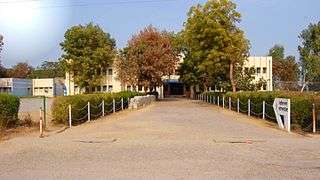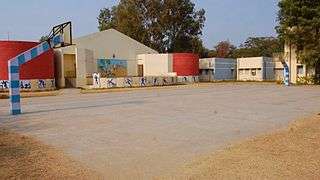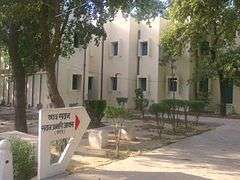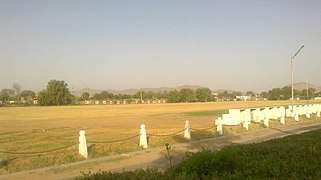Jawahar Navodaya Vidyalaya
Jawahar Navodaya Vidyalayas (JNVs) is a system of schools for talented students predominantly from rural area in India. They are run by Navodaya Vidyalaya Samiti, New Delhi, an autonomous organization under the Department of School Education and Literacy, Ministry of Human Resource Development, Government of India. JNVs are fully residential and co-educational schools affiliated to Central Board of Secondary Education (CBSE), New Delhi, with classes from VI to XII standard. JNVs are specifically tasked with finding talented children in rural areas of India and providing them with an education equivalent to the best residential school system, without regard to their families' socio-economic condition.[1]
| Jawahar Navodaya Vidyalaya | |
|---|---|
 | |
| Location | |
All over India except state of Tamil Nadu India | |
| Information | |
| Other name | JNV, Navodaya |
| Type | Public |
| Established | 1986 |
| Founder | Government of India |
| School board | CBSE |
| Chairman | Ramesh Pokhriyal |
| Faculty | Hostel, Mess, Education, Games etc. |
| Grades | VI - XII |
| Age range | 11-19 yrs |
| Number of students | 265574 as on 31.03.2019 , https://navodaya.gov.in/nvs/en/Academic/Student-Profile/ |
| Campus size | 30 Acres each school |
| Campus type | Residential |
| Color(s) | [Navy blue and White] |
| Website | navodaya.gov.in |
The Navodaya Vidyalaya system is a unique experiment unparalleled in the annals of school education in India and elsewhere. Its significance lies in the selection of talented rural children as the target group and the attempt to provide them with quality education comparable to the best in a residential school system. Such children are found in all sections of society, and in all areas including the most backward.
The Budget for Education, Boarding and activities at JNVs are provided by Ministry of HRD, Government of India and it's free of cost for the students during the 7 years of stay.
JNVs exist all over India, with the exception of Tamil Nadu.[2] There are approximately 661 JNVs across India as of 2016-17 academic year.[3]
History
The idea of Jawahar Navodaya Vidyalayas conceived by former Prime Minister of India Rajiv Gandhi.[4][5] The concept of opening a JNV in every district of India was born as a part of the National Policy on Education, 1986 with an aim of providing excellence coupled with social justice.[6] Subsequently, Navodaya Vidyalaya Samiti (NVS) was registered as a society under the Societies Registration Act, 1860.[6]
As per policy of the government, one JNV was to be established in each district of country. To start with, two Jawahar Navodaya Vidyalayas were established during 1985–86, at Jhajjar (Haryana) and Amravati (Maharashtra).[6] As of the 2015–16 academic session, JNVs had been sanctioned for 576 districts. In addition, ten JNVs have been sanctioned in districts having a large population of ST population, ten in districts having a large concentration of SC population and two special JNVs in Manipur, bringing the total number of sanctioned JNVs to 598.[7] Out of these 591 JNVs are functional.[8] In November 2016, the Cabinet Committee on Economic Affairs (CCEA) approved the opening of one JNV in each of the 62 uncovered districts.[8] That will bring the total number of JNVs to 660 once operational.
Organisational structure
Navodaya Vidyalayas are run by the Navodaya Vidyalaya Samiti (NVS), an autonomous organisation under the Ministry of Human Resource Development, Department of School Education and Literacy, Govt. of India. The Chairman of the Samiti is the Minister of Human Resource Development.[9][10]
The Samiti functions through the Executive Committee under the Chairmanship of the Minister of HRD. The Executive Committee is responsible for the management of all affairs including allocation of funds to the Samiti and has the authority to exercise all powers of Samiti. It is assisted by two sub-committees, the Finance Committee and Academic Advisory Committee.[10] The executive head of the administrative pyramid is the Commissioner who executes the policies laid down by the Samiti's Executive Committee. He/she is assisted at the Headquarters level by Joint Commissioners, Deputy Commissioners and Assistant Commissioners. The Samiti has established eight regional offices for the administration and monitoring of Navodaya Vidyalayas under their jurisdiction. These offices are headed by a deputy commissioner and assistant commissioners.[10]
For each JNV, there is a Vidyalaya Advisory Committee for assistance on matters of academics, infrastructure and other general activities and a Vidyalaya Management Committee for budget preparation, selection of ad-hoc teachers and proper functioning of the school.[9] Normally the district collector of the concerned district is the ex-officio chairman of school level committees with local educationists, public representatives and officers from the district as members. Some schools also have a Vidhyalaya Coordination Committee for looking after performance of academics.[9][10]
List of schools
At present, there are 598 functional residential schools, which are administrated, according to the following table, by eight regional offices located at Bhopal, Chandigarh, Hyderabad, Jaipur, Lucknow, Patna, Pune and Shillong with jurisdiction over different states and UTs.[10]
| Regions (no. of JNVs) | States/UTs (respective no. of JNVs) | Prominent JNVs in state/UT |
|---|---|---|
| Bhopal (113)[11] | Madhya Pradesh (54) | Panna, Bhopal, Ashok Nagar, Indore, Khurai, Rampura, Shyampur, Narsinghpur |
| Chhattisgarh (28) | Raipur, Dongargarh, Basdei, Malhar, Korba, Kabirdham, Janjgir-Champa | |
| Odisha (31) | Bhubaneswar, Hadagarh, Bagudi, Belpada, Tarbha, Mundali, Narla, Rayagada, Boudh | |
| Chandigarh (59) | Punjab (23) | Patiala |
| Himachal Pradesh (12) | Nahan (Sirmaur), Theog (Shimla) | |
| J&K (23) | Srinagar, Doda, Jawahar Navodaya Vidyalaya, Baramulla, Jawahar Navodaya Vidyalaya,Budgam, Ganderbal, Jawahar Navodaya Vidyalaya, Pulwama, Jawahar Navodaya Vidyalaya, Anantnag, Kupwara Udhampur[12] | |
| Chandigarh(1) | Chandigarh | |
| Hyderabad (77) | Andhra Pradesh(15) | Pedavegi (West Godavari), Peddapuram, Prakasam, Valasapalle, Veleru
Vennelavalasa, Kiltampalem (vizianagaram), Kommadi (visakhapatnam) |
| Telangana (9) | Vattem (Mahabubnagar), Choppadandi (Karimnagar), Nizamasagar, Warangal(Mamnoor), Medak(Wargal) | |
| Karnataka (31) | Bangalore Rural, Bangalore Urban, Shimoga, Kodagu, Gadag, Belgaum, Mandya , Raichur, Bagalkot, Belagavi, BALLARI, Bidar, Bijapur, Chamarajnagar, Chikmagalur, Chitradurga, Davangare, Dharwad,Yadgiri, Hassan, Haveri, Chickballapura, Koppal, Mysore, South Kannada, Uttara Kannada, Tumkur, Udupi, Kalaburagi, Ramanagara | |
| Kerala (14) | Kannur, Kasaragod, Kollam, Ernakulam, Pathanamthitta, Thrissur, Kottayam, Wayanad, Thiruvananthapuram, Palakkad, Kozhikode, Alappuzha, Malappuram and Idukki. | |
| Puducherry (4) | Periyakalapet, [[Jawahar Navodaya Vidyalaya, Karaikal|Karaikal],Yanam[Mettakur] | |
| A & N Islands (3) | Middle Andaman | |
| Lakshadweep (1) | Lakshadweep | |
| Jaipur (65) | Rajasthan (35) | Nagaur, Jaipur, Karaui, Churu, Jaswantpura, Jojawar, Mandaphia, sikar, Baran, Barmer, Jaisalmer, jodhpur, bikaner |
| Haryana (21) | Faridabad, JNV jhajjar | |
| Delhi (9) | JNV mungeshpur, JNV jaffarpur kalan | |
| Lucknow (89) | Uttar Pradesh (76) | Kanpur, Kanpur Dehat, Amroha, Ballia, Bhogaon, Mirzapur, Sitapur, Barabanki, Sonbhadra, Chandauli, Raebareli, Bijnor |
| Uttaranchal (13) | ||
| Patna (85) | Bihar (39) | Sheikhpura,Buxar,Bihiya, Madhubani, West Champaran |
| Jharkhand (26) | Deoghar, Hazaribagh, Ranchi, Sahibganj | |
| West Bengal (20) | Alipurduar, Bankura, Birbhum, Coochbehar, Hooghly, Paschim Bardhaman, North 24 Parganas, South 24 Parganas, Dakshin Dinajpur, Uttar Dinajpur, Nadia, Berhampore | |
| Pune (73) | Maharashtra (34) | Ahmednagar, Nanded, Nashik, Palghar, Tuljapur (Osmanabad), Buldhana, Satara, Bhusawal, Yavatmal, Amravati, Wardha |
| Gujarat (34) | Porbandar, Jamnagar, Rajkot, Ahmedabad, Amreli, Anand, Aravali, Banaskantha, Kutch, Patan, Surendranagar | |
| Goa (2) | Canacona, North goa | |
| Dadra and Nagar Haveli and Daman and Diu (1+2) | Sili Dadra & Nagar, Haveli, Dunetha, Bucharwada | |
| Shillong (100) | Meghalaya (8) | Williamnagar, Baghmara, Mahendraganj |
| Manipur (11) | Pfukhro Mao | Umathel |
| Mizoram (8) | Champhai | |
| Arunachal Pradesh (18) | Megdong | |
| Nagaland (11) | Mokokchung | |
| Tripura (8) | Dhalai, Dharmanagar North Tripura, Ramachandraghat Khowai West Tripura, Fulkumari South Tripura | |
| Sikkim (4) | North Sikkim, South Sikkim, West Sikkim, East Sikkim | |
| Assam (28) | Karimganj, Golaghat, Bongaigaon, Jorhat, Pailapool, Sonitpur, Rangia Kamrup, Kokrajhar, Darrang | |
| Meghalaya(12) |
Admission
Admission to Class VI of the JNVs requires qualification in the (JNVST), an entrance exam designed, developed and conducted by the CBSE.[13][14] JNVST for Class VI is conducted annually throughout the country to select the 80 most meritorious students for each JNV. It is conducted in three phases per year, depending upon the session structure in the specific state or union territory.[14][13] Candidates can apply for the test only once during their Class V.[13] Competition in the entrance exam can be gauged from fact that in JNVST 2015, a total of 1,878.15 thousand students appeared and 41.48 thousand students were selected (i.e. approx 2% pass percentage)[14][13] The test encompasses mental ability skills, mathematics, and regional language. The schools provide reservation as per NVS policy which encompasses reservation for ST and SC (but not OBC),[15] at least 75% selection of students from rural areas, maximum 25% from urban areas, fixed 33% for female students and 3% for disabled candidates.[13]
To compensate for attrition and optimally utilize seats, JNVST, developed by CBSE, is also conducted for a admission to Class IX[14][13] and lateral admissions, based on merit in Class X, are made for Class XI.[13]
Campus of JNVs
These campuses are usually located in hinterlands possibly to provide a serene environment and due to the unavailability of land near urban centers. Norms stipulate approx 30 acres (12.14 hectares) of land for each school to be provided free of cost by the state government. Normally a school has an academic block, residential blocks for both students and staff, play grounds and mess. The academic block consists of classrooms, library, laboratories, computer center and convention halls. Residential buildings are provided for students (usually separate hostels for boys and girls), faculty, and staff. Rajiv Smriti Van, in memory of former Prime Minister of India, Shri Rajiv Gandhi, is an integral part of all NVS campuses.[16]
 Academic block at a JNV
Academic block at a JNV A basketball court at a JNV
A basketball court at a JNV A hostel at a JNV
A hostel at a JNV A playground at a JNV
A playground at a JNV
Academics at JNVs
JNVs have classes from VI to XII standard. A particular JNV usually provides two streams among Science, Arts and Commerce for Class XI and XII. JNVs are known for their academic excellence,[17] which can be attributed to their merit-based entrance test and unique climate provided for otherwise disadvantaged children,[18] and which is further proven by their performance at board examinations. More than half of JNVs have been equipped with smart classes. These schools regularly organize science congress and exhibitions to promote a research mindset.[19]
Three-language formula
To facilitate migration every JNV learns three languages in class VI to Class IX.[20] These languages are grouped into A Level, B-I Level and B-II Level. The pattern followed in different categories of states is as shown in the table below. However, CBSE mandates for children to study two languages only. Therefore, students of each category of states appear for A Level and B-I level languages at CBSE examinations.[20]
| Category of state | A Level language | B-I Level language | B-II Level language |
|---|---|---|---|
| Hindi Speaking | Hindi | English | Regional language |
| Non-Hindi Speaking (excluding NE states) | Regional language | English | Hindi |
| North-East States | English | Hindi | Regional language |
Board results
JNVs has consistently produced the best results in CBSE board examinations over the years.[21] In 2015-16 results, JNVs had a pass percentage of, 98.87% in Class X board exams[22] and 96.73% in Class XII board exams.[23] The pass percentage for JNVs has been higher than independent private schools, government schools and even Kendriya Vidyalayas. Quality of performance in the Board examinations have been exemplary with average score of about 75% in Grade 12th and 78% in class 10th, with more than 89% students scoring First Division scores, in the Board Examinations 2019.
Science Promotion Activities
Navodaya Vidyalaya Samiti provides for various experiences leading to science promotion and motivation to students to select STEM as their career. Various activities under this include: Children Science Congress, Participation in multiple academic contests/Challenges/Olympiads, visit to Research Institutes, Tinkering Labs in schools, Environmental activities, Arranging International exposure to students, Enriched ICT support and Entrepreneurial skill trainings.
The annual Science Congress is organized annually in collaboration with research institutes and institutes of national importance at regional level. Exhibitions are organized at school, cluster, regional and national level for physics, chemistry Biology and maths.
Smart classes
Navodaya Vidyalayas in collaboration with Samsung India set up smart classes in 450 JNVs and 7 Navodaya Leadership Institutes from 2013 to 2019.[24] A smart class is typically equipped with an interactive Smartboard, laptops/tablets, Wi-Fi connectivity and power backup. A smart class supplements regular lessons in mathematics, science social science, English, and Hindi to explain concepts in an engaging and interactive manner. Teachers are trained to use the equipment effectively.[25]
Social and cultural life
The social milieu of JNVs is defined by the mingling of different sections of society from various regions of India since these schools follow the affirmative action policy and have a policy for migration from different linguistic regions. Teachers, chosen from across the country, live in the same campus and interact with students on 24X7 basis leading to a familial feeling.[26] The life of a Navodayan is enriched by extracurricular activities like sports, cultural activities and activities of youth organizations.
Migration
One of the important features of the JNV scheme is the Migration Programme wherein two linked JNVs of different linguistic categories exchange students between them.[18] The aim of the exchange program is to "promote national integration and enrich social content".[20] According to the scheme, a selected 30% of Class IX students are exchanged between two linked JNVs of different linguistic categories (generally between Hindi-speaking and non-Hindi-speaking states) for one year. During the migration period the three languages being taught to migrated students remain the same as in their parent JNV, but social and cultural exchanges are facilitated by their language learning in Class VI to IX.[20] Initially migration was envisaged for students from Class IX to Class XII; it was reduced to two years (Class IX and Class X) in 1991–92. Finally in 1996-97 it was confined to only Class IX students.[20]
Sports
JNVs give great emphasis to sports. The daily schedule allots at least two hours a day toward sports and other play activities. Each JNV provides facilities for handball, football, volleyball, basketball, kho-kho, badminton, kabaddi, hockey, and cricket. The campuses also provide a gymnasium and multi-purpose halls for indoor games like table tennis and chess. Inter-school competitions are held yearly at the cluster, regional, national, and SGFI (School Games Federation of India) level.
Cultural activities
Cultural activities are part of the JNV framework. Every school is provided with a music room and arts room. Inter-school competitions for dance, drama, debates, literature, etc. are yearly held at the cluster, regional and national level.
Scouting and Guiding, NCC and NSS
Navodaya Vidyalaya Samiti is recognised as a state for Scouting and Guiding activities by the Bharat Scouts and Guides (BSG). Navodaya students regularly participate in programmes of BSG. NCC is being introduced into the JNVs in a phased manner.[27] Similarly the National Service Scheme (NSS) is being introduced in a phased manner.
Emulation of the Navodaya Vidyalaya system
Emulating the concept of residential schools for talented children, Odisha State plans to set up one Odisha Adarsha Vidyalaya (OAV) (literally "Odisha Model School") at each of 314 block headquarters.[28] 160 schools have already been launched.[29] These Adarsha Vidyalayas would be CBSE-affiliated fully residential schools, provide free education, and target talented students through an annual entrance examination. These would have Class VI through Class XII and each class would have 80 students. These schools would be administered through Odisha Adarsha Vidyalaya Sangathan, a society registered under the Society Registration Act of Odisha.[30]
Concerns over care given to students
Incidents of suicide among students and the lack of apparatus to engage with such issues concerning health and discrimination plague the schools.[31] This has affected the Dalit and Tribal students more and there is no method in place to avoid such incidents.[32][33] There is no system in place to report the cases of inadequate care and abuse by staff, much of attention from the school administration in the form of mundane bureaucratic procedures comes after the occurrence of violation.[34][35]
Notable alumni
While Navodaya Vidyalayas have only recently started functioning, they have produced alumni in almost every field including engineers,[36] doctors, chartered accountants, civil servants[37] and entrepreneurs.[38][39] Schooling seldom directly leads to these success stories but Navodaya Vidyalayas have played a critical role in their success considering their background.[40]
Notable alumni include:
- Surendra Poonia, international award-winning sportsman and Limca book record holder.
- Sanjeev Mohapatra, Indian Cinematographers.
- C.K. Vineeth, India national football team member and Kerala Blasters Player.
- V.T. Balram, Current MLA of Thrithala Constituency, Kerala since May 2011.
- Dhananjay Kannoujia, Current MLA of Belthara Road Constituency, Uttar Pradesh since March 2017.
- Dheeraj Singh Moirangthem, Indian Under-17 football team member and Kerala Blasters Player.
- Ummer Fayaz Parray, Indian Army officer who was abducted and killed in Kashmir.
- Lalit Prabhakar, Marathi Actor
See also
- Kendriya Vidyalayas, another chain of CBSE schools under MHRD, Government of India
- Ministry of Human Resource Development (MHRD), Government of India
References
- "NVS Overview". Archived from the original on 30 March 2013. Retrieved 2 December 2011.
- "Navodyas in Tamil Nadu". The Hindu. 24 October 2011. Retrieved 10 March 2017.
- "Establishment of JNVs". Retrieved 10 March 2017.
- "Chalking a new path". India Today. 15 June 1988.
- "29 years and 589 schools later, Rajiv brainchild a rural hit". Times of India. 21 June 2015.
- "MHRD Annual Report 2014-15" (PDF). MHRD, GoI. p. 67. Retrieved 11 March 2017.
- "Navodaya Vidyalaya Samiti". NVS. Retrieved 4 November 2016.
- "Cabinet approves setting up of Jawahar Navodaya Vidyalayas in 62 uncovered districts of the country". Press Information Bureau, Government of India. 23 November 2016. Retrieved 11 March 2017.
- "Evaluation Study on Navodaya Vidyalaya Smiti(NVS)" (PDF). NITI Aayog. March 2015. pp. 16–20. Retrieved 11 March 2017.
- Jawahar Navodaya Vidyalaya, NVS. "Regional Offices of NVS". Navodaya vidyalaya samiti. NVS. Retrieved 11 March 2017.
- jawahar navodaya vidyalaya, NVS. "Regional Offices of NVS". NVS.
- "Navodaya Vidyalaya in Jammu and Kashmir". Retrieved 22 June 2019.
- "Jawahar Navodaya Vidyalaya Selection Test". Navodaya Vidyalaya Samiti(NVS). Retrieved 10 March 2017.
- "CBSE Annual Report 2015-16" (PDF). pp. 37–38. Retrieved 10 March 2017.
- "No reservation for OBC in JNV is an anomaly: Union Minister of State for HRD". India Today. 17 January 2017. Retrieved 10 March 2017.
- "Evaluation Study on Navodaya Vidyalaya Samiti(Ch-6)" (PDF). pp. 26–35. Retrieved 17 March 2017.
- "Evaluation Study on Navodaya Vidyalaya Samiti(Ch-15: Education with Excellence)" (PDF). NITI Aayog, GoI. pp. 77–92. Retrieved 18 March 2017.
- "Migartion of Students for National Integration". NVS, GoI. Retrieved 17 March 2017.
- "Bangalore students part of science fest in LA". Times of India. 14 May 2014.
- "Evaluation Study on Navodaya Vidyalaya Samiti(Ch-13)" (PDF). NITI Aayog, GoI. pp. 73–74. Retrieved 15 March 2017.
- "Academic Activities". NVS. Retrieved 17 March 2017.
- "CBSE Class 10 results". Hindustan Times. 28 May 2016. Retrieved 17 March 2017.
- "10 things to know about CBSE Class 12 exam results 2016". Hindustan Times. 22 May 2016. Retrieved 17 March 2017.
- "Replacing the chalk and the blackboard". The Hindu. 6 January 2017. Retrieved 18 March 2017.
- "Samsung Smart Class takes digital literacy to rural India". Economic Times. 27 November 2016.
- "Where the gates open to academic excellence". Times of India. 28 June 2016.
- "NCC cadets at camp get rescue operation tips". The Hindu.
- "About Us". Odisha Adarsha Vidyalaya Sangathan. Retrieved 18 March 2017.
- "Odisha launches 100 Adarsha Vidyalayas". Times of India. 5 April 2016. Retrieved 18 March 2017.
- "Naveen launches Adarsh Vidyalaya project". The Hindu. 6 April 2016. Retrieved 18 March 2017.
- "Navodayas struggle with student suicides: Overworked teachers, lack of counsellors". The Indian Express. 4 February 2019. Retrieved 3 October 2019.
- "Suicides in Navodaya schools: 49 in 5 years, half of them Dalit and tribal students". The Indian Express. 4 February 2019. Retrieved 3 October 2019.
- "'This place is like hell': Navodaya Vidyalaya tribal student allegedly kills self in hostel, leaves 'note'". The New Indian Express. Retrieved 3 October 2019.
- "Lakhimpur: FIR against JNV teacher for 'molesting' Class 7 student". Hindustan Times. 26 April 2018. Retrieved 3 October 2019.
- Pioneer, The. "Parents' demand for CBI probe forwarded to govt". The Pioneer. Retrieved 3 October 2019.
- "Jawahar Navodaya shine, 233 of 315 kids get into IITs". The Economic Times.
- "'I want to be the real servant of people'". Times of India. 6 July 2015.
- "Evaluation Study on Navodaya Vidyalaya Samiti(Ch-15: Education with Excellence)" (PDF). NITI Aayog, GoI. p. 80. Retrieved 18 March 2017.
- "Navodaya helps rural kids rise up to urban challenge, excel in all fields". Times of India. 2 June 2015.
- "'If not for this school, I would not have studied at all'". Times of India. 21 June 2015. Retrieved 18 March 2017.